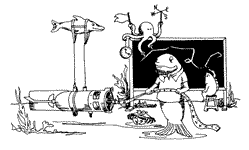|
|
|
| |
Home
Abstracts
Technical Program
Schedule of presenters and events.
Accomodations
Reserving your room at the Bahia Hotel
Order the Proceedings
Information and order form.
Committee and Contact Info
Who and how to contact the presenters and organizers.
|
|
| |
|
|
Constructing Surface Current Maps from HF Radars with Different Operating
Frequencies
John F. Vesecky1, Jessica Drake1, Kenneth Laws1,
Calvin Teague2, Dan Fernandez3 and Jeff Paduan4
1221 Baskin Engineering Bldg
EE Dept., University of California at Santa Cruz
1156 High St.
Santa Cruz, CA 95064
phone: 831-459-4099
email: Vesecky@soe.ucsc.edu
2STAR Lab.
EE Dept., Stanford Univ.
Stanford, CA 94305
3Inst. of Earth Systems Science & Policy
Calif. St.
Univ. Monterey Bay, Seaside CA 93955
4Dept. of Oceanography
Naval Postgraduate School
Monterey, CA 93943
HF radars operating at decameter wavelengths (3 to 30 MHz) in ground
wave mode are capable of mapping surface currents, waves and winds
over relatively large coastal ocean areas (˜ a few thousand sq.
km.). Several different HF radar systems are in operation, using different
radar system concepts, processing methods and radar frequencies. Users
of the data products of HF radars need to know how to merge the data
from these different systems into a single set of current maps. Monterey
Bay provides a useful test bed for developing algorithms and tools
for processing and merging HF radar observations from these different
systems, namely Seasonde units from CodarOS Ltd. and multifrequency
coastal radars (MCR’s) developed by a consortium based at the
University of Michigan. During the year 2000 two MCR’s operating
at 4.8, 6.8, 13.4 and 21.8 MHz were sited at Moss Landing and Santa
Cruz, California, collecting current maps at hourly intervals. At
the same time three Seasonde units were operating from the aforementioned
two sites and from Pt. Pinos as well. This suite of radars provided
excellent coverage of Monterey Bay. We review observations by both
these systems during the summer of 2000. First, we compare the current
maps generated by the Seasonde units (operating at 12, 13 and 25 MHz)
with observations by MCR units using the frequencies above. We show
that both systems produce currents maps with generally the same character,
but still with significant differences. We investigate the impact
of the different frequencies of operation on the resulting current
maps. In particular we compare maps of the same current field and
the same time, but made with radars operating on different frequencies.
We then discuss methods for adjusting the data from different frequencies
to a single basis. We argue that these methods allow radar data from
different systems to be merged in a more effective manner than simply
using HF radar data from radars operating on different frequencies
without regard to operating frequency.
Submitted on January 22, 2003
|
